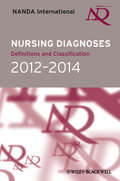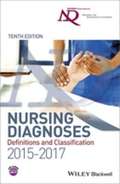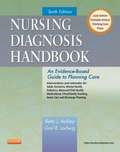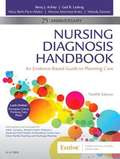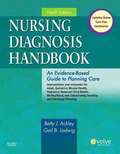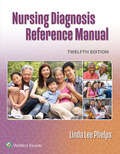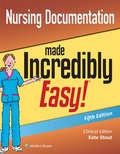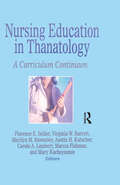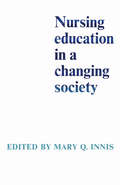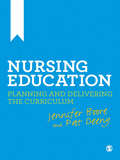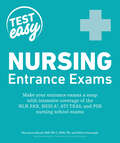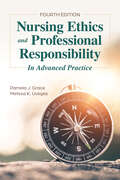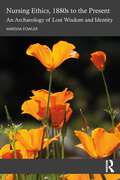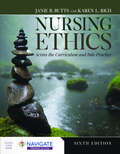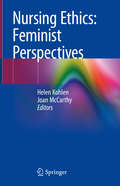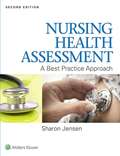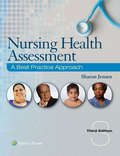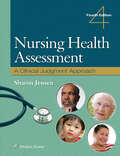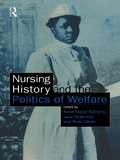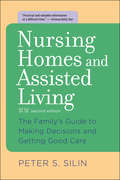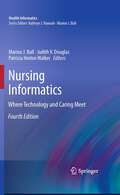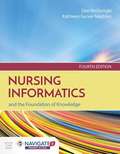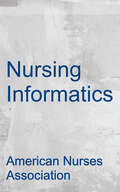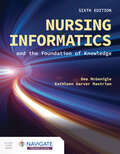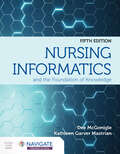- Table View
- List View
Nursing Diagnoses
by NANDA InternationalA nursing diagnosis is defined as a clinical judgment about individual, family or community responses to actual or potential health problems or life processes which provide the basis for selection of nursing interventions to achieve outcomes for which the nurse has accountability (NANDA-I, 2009). Accurate and valid nursing diagnoses guide the selection of interventions that are likely to produce the desired treatment effects and determine nurse-sensitive outcomes.Nursing diagnoses are seen as key to the future of evidence-based, professionally-led nursing care - and to more effectively meeting the need of patients. In an era of increasing electronic patient health records, standardized nursing terminologies such as NANDA-I, NIC and NOC provide a means of collecting nursing data that are systematically analysed within and across healthcare organizations and provide essential data for cost/benefit analysis and clinical audit.Nursing Diagnoses: Definitions and Classification is the definitive guide to nursing diagnoses, as reviewed and approved by NANDA-I. Each nursing diagnosis undergoes a rigorous assessment process by NANDA-I's Diagnosis Development Committee, with stringent criteria used to indicate the strength of the underlying level of evidence.Each diagnosis comprises a label or name for the diagnosis, a definition, defining characteristics, risk factors and/or related factors. Many diagnoses are further qualified by terms such as risk for, effective, ineffective, impaired, imbalanced, self-care deficit, readiness for, disturbed, decreased, etc.The 2012-2014 edition is arranged by concept according to Taxonomy II domains, i.e. Health promotion, Nutrition, Elimination and exchange, Activity/Rest, Perception/Cognition, Self-perception, Role relationships, Sexuality, Coping/ Stress tolerance, Life principles, Safety/protection, Comfort, and Growth/development.The 2012-2014 edition contains revised chapters on NANDA-I taxonomy, and slotting of diagnoses into NANDA & NNN taxonomies, diagnostic reasoning & conceptual clarity, and submission of new/revised diagnoses. New chapters are provided on the use of nursing diagnoses in education, clinical practice, electronic health records, nursing & health care administration, and research . A companion website hosts related resources.Key features2012-2014 edition arranged by diagnostic conceptsCore references and level of evidence for each diagnosisNew chapters on appropriate use of nursing diagnoses in clinical practice, education, administration and electronic health record16 new diagnoses11 revised diagnosesAimed at students, educators, clinicians, nurse administrators and informaticiansCompanion website available, including a video on assessment, clinical reasoning and diagnosis
Nursing Diagnoses 2015-17
by NANDA InternationalNursing Diagnoses: Definitions and Classification is the definitive guide to nursing diagnoses, as reviewed and approved by NANDA-I. The 2015-2017 edition of the classic and internationally recognised text has been rigorously updated and revised, and now provides more linguistically congruent diagnoses as a result of the Diagnostic Development Committee's attentiveness to understanding the translation of the diagnostic label, definition, defining characteristics, related factors, and risk factors. Each of the 235 diagnoses presented are supported by definitions as well as defining characteristics and related factors, or risk factors. Each new and revised diagnosis is based on the latest global evidence, and approved by expert nurse diagnosticians, researchers, and educators.New to this edition:26 brand new nursing diagnoses and 13 revised diagnosesUpdates, changes, and revision to the vast majority of the nursing diagnosis definitions, in particular the Health Promotion and Risk DiagnosesA standardization of diagnostic indicator terms (defining characteristics, related factors, and risk factors) to further aid clarity for readers and cliniciansAll introductory chapters are written at an undergraduate nursing level, and provide critical information needed for nurses to understand assessment, its link to diagnosis, and the purpose and use of taxonomic structure for the nurse at the bedsideA new chapter, focusing on Frequently Asked Questions, representing the most common questions received through the NANDA-I website, and at global conferencesFive nursing diagnoses have been re-slotted within the NANDA-I taxonomy, following a review of the current taxonomic structureCoding of all diagnostic indicator terms is now available for those using electronic versions of the terminologyCompanion website featuring references from the book, video presentations, teaching tips, and links to taxonomy history and diagnosis submission/review process description www.wiley.com/go/nursingdiagnoses
Nursing Diagnosis Handbook: An Evidence-Based Guide to Planning Care (10th Edition)
by Betty J. Ackley Gail B. LadwigThe 10th edition of the Nursing Diagnosis Handbook makes formulating nursing diagnoses and creating individualized care plans a breeze. Updated with the most recent NANDA-I approved nursing diagnoses, this convenient reference shows you how to build customized care plans in three easy steps: assess, diagnose, plan. Authors Elizabeth Ackley and Gail Ladwig use Nursing Outcomes Classification (NOC) and Nursing Interventions Classification (NIC) to guide you in creating care plans that include desired outcomes, interventions, patient teaching, and evidence-based rationales. Unique! Care Plan Constructor on the companion Evolve website offers hands-on practice creating customized plans of care. Alphabetical thumb tabs allow quick access to specific symptoms and nursing diagnoses.Suggested NIC interventions and NOC outcomes in each care plan. Recent and classic research examples promote evidence-based interventions and rationales. NEW! 4 Color textNEW! Includes updated 2012-2014 NANDA-I approved nursing diagnosesNEW! Provides the latest NIC/NOC, interventions, and rationales for every care plan.NEW! QSEN Safety interventions and rationalesNEW! 100 NCLEX exam-style review questions are available on the companion Evolve website.NEW! Root Causing Thinking and Motivational Interviewing appendixes on the companion Evolve website.
Nursing Diagnosis Handbook: An Evidence-based Guide to Planning Care
by Betty J. Ackley Gail B. Ladwig Melody Zanotti Mary Beth Flynn Makic Marina Reyna Martinez-KratzThis convenient handbook shows you how to correlate nursing diagnoses with known information about clients on the basis of assessment findings, established medical or psychiatric diagnoses, and the current treatment plan. Extensively revised and updated with the new 2018-2020 NANDA-I approved nursing diagnoses, it integrates the NIC and NOC taxonomies, evidence-based nursing interventions, and adult, pediatric, geriatric, multicultural, home care, safety, and client/family teaching and discharge planning considerations to guide students in creating unique, individualized care plans.
Nursing Diagnosis Handbook: An Evidence-based Guide to Planning Care (9th Edition)
by Betty J. Ackley Gail B. LadwigThis edition shows you how to build customized care plans using a three-step process: assess, diagnose, and plan care. It includes suggested nursing diagnoses for over 1,300 client symptoms, medical and psychiatric diagnoses, diagnostic procedures, surgical interventions, and clinical states.
Nursing Diagnosis Reference Manual
by Linda PhelpsBoost students’ clinical confidence and practice readiness with the latest evidence-based information for nursing diagnoses. Nursing Diagnosis Reference Manual, 12th Edition, provides fast, efficient access to clearly written, comprehensive coverage of the 2021-2023 NANDA-I definitions and classifications to help students meet the evolving healthcare needs of today’s patients. Approachable monographs—thoroughly updated and alphabetized for quick, easy reference—reflect the nursing process and the expertise of leading nursing clinicians, educators, and researchers to equip students for clinical success in any setting.
Nursing Documentation Made Incredibly Easy (Incredibly Easy! Series®)
by Kate StoutPublisher's Note: Products purchased from 3rd Party sellers are not guaranteed by the Publisher for quality, authenticity, or access to any online entitlements included with the product. Feeling unsure about the ins and outs of charting? Grasp the essential basics, with the irreplaceable Nursing Documentation Made Incredibly Easy!®, 5th Edition. Packed with colorful images and clear-as-day guidance, this friendly reference guides you through meeting documentation requirements, working with electronic medical records systems, complying with legal requirements, following care planning guidelines, and more. Whether you are a nursing student or a new or experienced nurse, this on-the-spot study and clinical guide is your ticket to ensuring your charting is timely, accurate, and watertight. Let the experts walk you through up-to-date best practices for nursing documentation, with: NEW and updated, fully illustrated content in quick-read, bulleted format NEWdiscussion of the necessary documentation process outside of charting—informed consent, advanced directives, medication reconciliation Easy-to-retain guidance on using the electronic medical records / electronic health records (EMR/EHR) documentation systems, and required charting and documentation practices Easy-to-read, easy-to-remember content that provides helpful charting examples demonstrating what to document in different patient situations, while addressing the different styles of charting Outlines the Do's and Don’ts of charting – a common sense approach that addresses a wide range of topics, including: Documentation and the nursing process—assessment, nursing diagnosis, planning care/outcomes, implementation, evaluation Documenting the patient’s health history and physical examination The Joint Commission standards for assessment Patient rights and safety Care plan guidelines Enhancing documentation Avoiding legal problems Documenting procedures Documentation practices in a variety of settings—acute care, home healthcare, and long-term care Documenting special situations—release of patient information after death, nonreleasable information, searching for contraband, documenting inappropriate behavior Special features include: Just the facts – a quick summary of each chapter’s content Advice from the experts – seasoned input on vital charting skills, such as interviewing the patient, writing outcome standards, creating top-notch care plans “Nurse Joy” and “Jake” – expert insights on the nursing process and problem-solving That’s a wrap! – a review of the topics covered in that chapter About the Clinical Editor Kate Stout, RN, MSN, is a Post Anesthesia Care Staff Nurse at Dosher Memorial Hospital in Southport, North Carolina.
Nursing Education in Thanatology: A Curriculum Continuum
by Austin H. Kutscher Florence E. Selder Virginia W. Barrett Marilyn M. Rawnsley Carole A. Lambert Marcia Fishman Mary KachoyeanosNursing Education in Thanatology is an excellent source book for planning thanatology courses or for integrating concepts of thanatology into a nursing curriculum. As the formal teaching of thanatology in schools for health care professionals is generally overlooked and ill-defined, many students and professionals will learn to deal with dying and grieving upon their first encounter with death. This practical book will aid educators in planned inclusion of thanatology in curriculum to insure the preparedness of health care professionals in assisting patients and/or their families during an emotionally difficult period. There are many suggestions presented for beneficial methods of integrating thanatology education into existing courses or offering thanatology as a single course for education professionals.A vital resource for inservice coordinators working with clinicians in oncology, hospital staff, and health professionals in community or outpatient health centers, Nursing Education in Thanatology is excellent reading for helping professionals working with elderly people.
Nursing Education in a Changing Society
by Mary InnisRapid social change and the advances made in the field of health care have greatly changed the role and function of the nurse in the last fifty years. Nursing is now almost a full-fledged profession. This book celebrates the fiftieth anniversary of the School of Nursing of the University of Toronto. The field it covers is wide and varied – from care of the sick by the nuns of early Quebec to the development of pre-paid nursing plans, from concepts of "beside nursing" to "delivery health services." There are long looks into the future of nursing education and health care which include descriptions of health science centres, diagnosis by computer, and treatment centres in outer space. The book sketches the history of this pioneer school of nursing, surveys nursing legislation, and examines the rise of the public-health nurse and the nursing assistant. Essays contributed by leading Canadian authorities show a wide range of opinion: one writer wants to see the scope of nursing education enlarged, another thinks it is too broad already. At a time when nursing education is becoming an increasingly controversial subject, this book will be of interest and value to all those in the health field.
Nursing Education: Planning and Delivering the Curriculum
by Jennifer Boore Patrick DeenyNursing Education provides a strategic guide and practical focus to curriculum planning and development. It will help all those involved in the provision of nursing education to understand the issues involved at the different stages of preparing a nursing curriculum which: - meets both professional and academic requirements; - integrates theory and practice; - enables students to achieve the skills and competencies they need for professional practice; - includes different methods of teaching and learning; - provides clear guidance for student selection and assessment. Balancing theoretical principles with practical application, and linked closely to the NMC's 2010 standards for pre-registration nursing, Jennifer Boore and Pat Deeny illustrate clearly and accessibly how to develop tailored education programmes so that nurse educators and clinicians in practice can enable their students to provide up-to-date and appropriate patient care.
Nursing Entrance Exams (Test Easy)
by Robin Kavanagh Maryanne BaudoRest Easy with Test Easy!You're excited about your decision to pursue a career in nursing. And regardless of what type of nurse you plan to become--RN, LPN or LVN, CNS, nurse practitioner, or other specialization--you know that to get into the nursing program of your choice you'll have to do your absolute best on the entrance exams. Well, rest easy because Test Easy makes acing your exams a snap! In this book, you get:An overview of the NLN PAX, HESI, ATI TEAS, HOBET, and PSB Nursing School ExamsTips for boosting your grammar, vocabulary, and reading proficiency to pass the nursing exam verbal sectionMath essentials to get you comfortable with the arithmetic, algebra, and geometry nurses need to knowScience tutorials for boning up on the essentials of life science, anatomy & physiology, chemistry, and physicsPractice exams to test your progress, plus detailed answers to help you pass your exams with flying colors
Nursing Ethics and Professional Responsibility in Advanced Practice
by Pamela J. Grace Melissa K. UvegesNursing Ethics and Professional Responsibility in Advanced Practice, Fourth Edition, remains the only comprehensive textbook available on the ethical issues faced by APNs providing front-line care. It introduces the foundations of professional responsibility and makes difficult philosophical and ethical concepts accessible to students so they can facilitate their own ethical decision-making. The authors, an APN and ethicist, demystifies the principles and language of healthcare ethics. Beginning from a foundation of nursing practice, this unique resource guides students in developing ethical decision-making skills they can apply to a range of circumstances, from everyday issues to complex dilemmas. The updated Fourth Edition features expanded information on social justice, including advocacy for vulnerable populations and global issues, as well as new discussions on managing social media, electronic health records, and ethical issues specific to CRNAs and CNSs.
Nursing Ethics, 1880s to the Present: An Archaeology of Lost Wisdom and Identity
by Marsha FowlerThis important text draws on decades of research, arguing that modern nursing germinated and grew an ethics from its own native soil, which is rich, fulsome, and philosophically informed, grounded in the tradition and practice of nursing.It is an ethics with a positive agenda for the good nurse, a good society, a healthy people, and human flourishing. This native nursing ethics was forgotten, creating space for a foreign bioethics’ colonization of nursing in the second half of the twentieth century. Drawing from a wide range of sources from the USA, the UK, Canada, and Ireland, the book addresses the early and enduring ethical concerns, values, and ideals of nursing as a profession that engages in direct clinical practice and in developing policy. Fowler calls for reclaiming and renewing nursing’s ethical tradition.This systematic and comprehensive book is an essential contribution for students and scholars of nursing ethics.
Nursing Ethics: Across the Curriculum and Into Practice
by Janie B. Butts Karen L. RichNursing Ethics: Across the Curriculum and Into Practice continues to provide a solid ethical foundation for nursing students in an updated sixth edition. This comprehensive, easy-to-read text covers ethics across the nursing curriculum, making it a perfect fit for any undergraduate course. Logically divided into three parts, Nursing Ethics, Sixth Edition underscores how ethics is interwoven with nearly every aspect of professional nursing practice. It guides students through the foundations of ethics in nursing, ethical considerations across the lifespan, and ethical considerations for areas such as leadership and public health. Engaging learning features, including case studies, legal perspectives, and research notes bring concepts to life and serve to remind students that ethics really does sit at the heart of professional nursing practice and quality patient care.
Nursing Ethics: Feminist Perspectives
by Helen Kohlen Joan McCarthyThe aim of this book is to show how feminist perspectives can extend and advance the field of nursing ethics. It engages in the broader nursing ethics project of critiquing existing ethical frameworks as well as constructing and developing alternative understandings, concepts, and methodologies. All of the contributors draw attention to the operations of power inherent in moral relationships at individual, institutional, cultural, and socio-political levels. The early essays chart the development of feminist perspectives in the field of nursing ethics from the late 19th century to the present day and consider the impact of gender roles and gendered understandings on the moral lives of nurses, patients and families. They also consider the transformative potential of feminist perspectives to widen the scope of nursing and midwifery practices to include the social, economic, cultural and political dimensions of moral decision-making in health care settings. The second half of the book draws on feminist insights to critically discuss the role of nurses and midwives in leadership, healthcare organisations, and research as well as the provision of particular forms of care e.g. care in the home and abortion care.
Nursing Health Assessment: A Best Practice Approach
by Sharon JensenDevelop the assessment knowledge and skills you need for clinical practice with Nursing Health Assessment: A Best Practice Approach, 2e. This proven book emphasizes health promotion, risk factor reduction, evidence-based thinking, and diagnostic reasoning. You will learn strategies for adapting questions and techniques when communication is challenging, the patient's responses are unexpected, or the patient's condition changes over time. Unique features help you apply and analyze concepts and prepare you for effective practice in any health care setting. Normal and abnormal findings are presented in side-by-side columns and comprehensive examinations are included for each topic. Additional features, online resources, and book-related media build on the in-text cases to reinforce correct elements of subjective and objective data collection and variations necessary for different problems, age groups, and cultures. Learning Objectives highlight the key information you need to master by the time you have completed the chapter. Hundreds of full-color photos and illustrations help you retain important concepts. Clinical Significance features highlight content critically related to clinical application. Safety Alert boxes present important areas of concern or results that require immediate intervention or adjustments. A Threaded Case Study in every chapter demonstrates real-world application through a wide range of innovative features. Therapeutic Dialogue displays provide examples of "less effective" and "more effective" communication to help you hone the communication skills you will use with patients when gathering assessment data. SBARFramework (Situation, Background, Analysis or Assessment, and Recommendations) helps you organize details when coordinating referrals or other patient advocacy needs. Documenting Abnormal Findings: The results from the case are charted using the four techniques of physical assessment (Inspection, Palpation, Percussion, and Auscultation). Analyzing Findings: A sample SOAP note (Subjective Data, Objective Data, Analysis, and Plan) shows you how to analyze assessment information and plan care based upon the assessment. Reflection and Critical Thinking: One priority problem is identified and a plan of care is developed based upon the assessment. Structure and Function Overview sections review anatomy and physiology and provide additional content on variations related to lifespan and culture. Acute Assessment sections summarize emergency signs and symptoms to look for and immediate assessments and interventions to implement. Subjective Data Collection sections focus on areas for health promotion, risk assessment, and health-related patient teaching. and provide focused assessments for common symptoms. Objective Data Collection sections cover equipment, preparation, techniques, normal findings, abnormal findings, lifespan and cultural adaptations, and sample documentation. Evidence-based Critical Thinking sections explain how nurses analyze findings and take the next steps to address patients' concerns. Sections include Common Laboratory and Diagnostic Testing, Nursing Diagnosis/Outcomes/ Interventions, Organizing and Prioritizing, Collaboration with Other Health Care Professionals, and Applying Your Knowledge. Tables of Abnormal Findings cluster common abnormalities related to the specific assessment with compare-and-contrast information on key data points. NCLEX Review sections include 10 NCLEX-style test questions per chapter to help you master concepts and prepare for the boards.
Nursing Health Assessment: A Best Practice Approach (Coursepoint Ser.)
by Sharon JensenPublisher's Note: Products purchased from 3rd Party sellers are not guaranteed by the Publisher for quality, authenticity, or access to any online entitlements included with the product. Nursing Health Assessment: A Best Practice Approach Third Edition Sharon Jensen, MN, RN Develop the assessment knowledge and skills to excel in any clinical setting. Updated to reflect today’s changing healthcare environment, this unique, modern approach to health assessment guides you progressively through realistic clinical case scenarios, emphasizing health promotion, risk factor reduction, evidence-based thinking, and diagnostic reasoning. Effective strategies help you adapt questions and techniques to confidently manage communication challenges, unexpected patient responses, changes in a patient’s condition over time, and more. Highlights of the Third Edition Progressive Case Studies in each chapter help you capably apply concepts to clinical practice through: Therapeutic Dialogue displays that hone the communication and critical thinking skills essential for gathering assessment data. Progress Note sections that provide sample SOAP (Subjective data, Objective data, Analysis, and Plan) notes documenting summaries of findings, with accompanying critical thinking questions. Documenting Case Study Findings boxes that summarize abnormal findings in the physical examination (determined through inspection, palpation, percussion, and auscultation). Collaborating With the Interprofessional Team displays that feature SBAR (Situation, Background, Analysis or Assessment, and Recommendations) frameworks for effectively coordinating referrals or other patient advocacy needs. Clinical Reasoning in Action sections that demonstrate how to bring all the elements of assessment together to determine a nursing diagnosis and related goals, interventions, rationales, and evaluation criteria. NEW!Unfolding case-based vignettes written by the National League for Nursing place concepts in a realistic context and encourage classroom discussion. NEW! Concept Mastery Alerts clarify potentially confusing topics. Learning Objectives focus on critical information and can help you study more effectively. Clinical Significanceboxes emphasize content critically related to clinical application. Safety Alert boxes highlight areas of concern or results that require immediate intervention or adjustments. Key Points summarized at the end of each chapter reinforce the most important content at a glance. Review Questions help you identify content requiring additional review. Tables of Abnormal Findings facilitate fast, effective assessments. Accompanying interactive learning resources such as videos and animations, referenced with icons in the text, appeal to a variety of learning styles.
Nursing Health Assessment: A Clinical Judgment Approach
by Sharon Jensen Ryan SmockEquip students with the necessary clinical judgment for effective nursing health assessment with Nursing Health Assessment: A Clinical Judgment Approach, 4th Edition. This extensively revised and updated text combines fundamental knowledge and a progressive, student-friendly presentation with an emphasis on critical thinking and clinical decision-making to help students excel on the Next Generation NCLEX® and confidently transition to nursing practice.
Nursing History and the Politics of Welfare
by Anne Marie Rafferty Jane Robinson Ruth ElkanA quiet revolution has been sweeping through the writing of nursing history over the last decade, transforming it into a robust and reflective area of scholarship. Nursing History and the Politics of Welfare highlights the significant contribution that researching nursing history has to make in settling a new intellectual and political agenda for nurses.The seventeen international contributors to this book look at nursing from different perspectives, as it has developed under different regimes and ideologies and at different times, in America, Australia, Britain, Germany, India, The Phillipines and South Africa. They highlight the role of politics and gender in understanding nursing history and propose strategies for achieving greater recognition for nursing, and bringing it into line with other related health care professions.
Nursing Homes and Assisted Living: The Family's Guide to Making Decisions and Getting Good Care
by Peter S. SilinAlmost a decade ago, Peter S. Silin wrote Nursing Homes: The Family's Journey to provide family members with practical advice and emotional support. This successor volume incorporates the new and sometimes baffling world of assisted living. Nursing Homes and Assisted Living focuses on the psychological, emotional, and practical aspects of helping family members and seniors make a difficult transition.Silin approaches his subject with compassion and sensitivity, guiding readers through the process of finding the best possible care. He describes how nursing homes and assisted living facilities work and outlines the selection process; he explains how to prepare for the day a relative moves into a facility and suggests ways to help the resident settle in; he focuses on the family member's role in solving problems, obtaining good-quality care, and visiting. The author’s insights help caregivers cope with difficult decisions and deal with emotional issues such as guilt and grief, while celebrating the tender, rewarding aspects of being a caregiver. Vignettes from real-life caregivers narrating their experiences amplify Silin’s advice and will resonate with families. This book provides caregivers, family members, and seniors with the information they need to effect successful transitions. It is also a valuable tool for social workers, nurses, and family therapists.
Nursing Informatics
by Michelle R. Troseth Judith V. Douglas Diane J. Skiba Joyce E. Sensmeier Susan K. Newbold Donna Dulong Brian Gugerty Joan Kiel Marion J. Ball Patricia Hinton Walker Kathryn J. HannahLike the three editions that preceded it, this new edition targets markets in health care practice and educational settings. It addresses practicing nurses and nursing students, together with nursing leadership and nursing faculty. It speaks to nursing informatics specialists and--in a departure from earlier editions of this title--to all nurses, regardless of their specialty, extending its usefulness as a text as noted below. In recognition of the evolving electronic health information environment and of interdisciplinary health care teams, the book is designed to be of interest to members of other health care professions (quality officers, administrators, etc.) as well as health information technology professionals (in health care facilities and in industry). The book will include numerous relevant case studies to illustrate the theories and principles discussed, making it an ideal candidate for use within nursing curricula (both undergraduate and graduate), as well as continuing education and staff development programs. This book honors the format established by the first three editions by including a content array and questions to guide the reader. This 4th edition also includes numerous brief case studies that help to illustrate the theories and practices described within the various chapters. Most of these "mini-cases" are provided by members of professional nursing organizations that comprise the TIGER Initiative. These mini-cases are listed in the front matter and highlighted via formatting throughout the text.
Nursing Informatics And The Foundation Of Knowledge
by Dee McGonigle Kathleen MastrianNursing Informatics and the Foundation of Knowledge, Fourth Edition teaches nursing students the history of healthcare informatics, current issues, basic informatics concepts, and health information management applications. This comprehensive text contains basic through complex concepts to address the needs of the novice through innovator. The text takes the reader from the building blocks of informatics through complicated topics such as data mining, bioinformatics, and system development. The content is enhanced through its grounding in the Foundation of Knowledge Model founded by the authors. <P><P> The purpose of this text is to provide a set of practical and powerful tools to ensure that students gain a solid understanding of Nursing Informatics and is able to move from information through knowledge to wisdom. The field of Informatics is a rapidly growing and ever-changing. In accordance with industry changes the Fourth Edition has been update to include two competency based assessment tools: TANIC and NICA L3/L4. <P><P> New to the Fourth Edition <P><P>Coverage of change theory <P><P>Updates on EHR systems and their increased use <P><P>Information on SMART technologies and patient safety <P><P>New tools including wearables, connectivity, virtual patient tools, apps <P><P>Simulated clinical experiences <P><P>Emerging technologies <P><P>Navigate 2 Premiere Access
Nursing Informatics Scope And Standards Of Practice
by American Nurses AssociationNursing Informatics: Scope and Standards of Practice, 3rd Edition describes a competent level of nursing care at each level of nursing informatics practice and provides comprehensive overviews of the dynamic and complex practice of the nursing informatics specialty. Published by ANA, this book is informed by advances in health care and professional nursing practice. It contains national standards of practice and performance that define the who, what, where, when, why, and how of nursing informatics practice and is a vital reference for: Quality improvement initiatives Certification and credentialing Position descriptions and performance appraisals Classroom teaching and in-service education programs Boards of nursing members’ orientation programs and regulatory decision-making activities Nursing Informatics: Scope and Standards of Practice, 3rd Edition is intended to guide nurses, as well as administrators, legislators, regulators, legal counsel, and other interprofessional colleagues.
Nursing Informatics and the Foundation of Knowledge
by Dee McGonigle Kathleen MastrianNursing Informatics and the Foundation of Knowledge, Sixth Edition is a comprehensive resource that helps nursing students make sense of nursing informatics by illustrating how to use and apply knowledge situationally within their professional practice alongside the latest technologies and tools. A practical guide for understanding how to efficiently use modern technology in today's healthcare system, this award-winning nursing textbook teaches students how to acquire, process and disseminate knowledge. The authors use their unique Foundation of Knowledge Model throughout as an organizational structure by which to learn and teach nursing informatics. This comprehensive framework guides students through the basic building blocks of nursing informatics (nursing science, information science, computer science, cognitive science) before divig into the most current technologies, tools, and trends in nursing informatics.
Nursing Informatics and the Foundation of Knowledge
by Dee McGonigle Kathleen MastrianNursing Informatics and the Foundation of Knowledge, Fifth Edition is a foundational text for teaching nursing students the core concepts of knowledge management while providing an understanding of the current technological tools and resources available.
